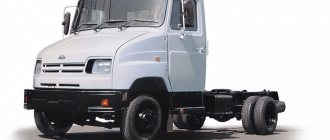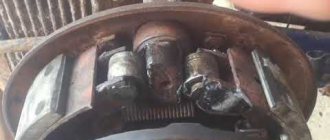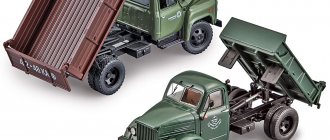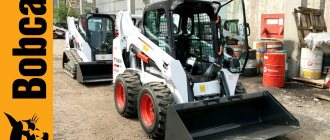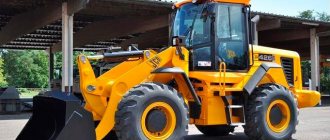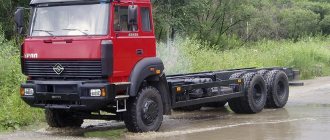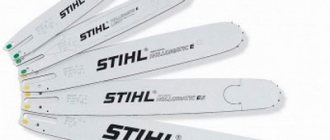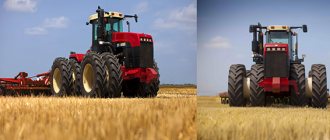The history of the Russian automotive industry is full of myths, often far from reality. Many authors quote unverified sources without bothering to verify the accuracy of the information. Thus, myths multiply, and it is very difficult to dispel established misconceptions.
One example of such myth-making is the history of the appearance of the ZIL-131 dump truck. You can find many articles that claim that this machine was created on the basis of the previously produced ZIL-157 model. They cause only restrained bewilderment among specialists. The differences in the design of the main units are obvious. But the design and history of the creation of the ZIL-157 is a separate topic. It is worth limiting ourselves to the fact that a dump truck has never been produced on the basis of this car.
Zil-131 collective farmer
Questions can only be asked after registration.
Please login or register. In the fall I decided to start building a dump truck, and this is what happened
One of these days I’ll finish the sides, paint them, install lights and mudguards. I’ll post pictures after all the finishing touches.
+++ I wish for our land of peaceful sky above our heads, and for those who want to spare us - peaceful land above our heads
Handsome
Add two main springs to the rear springs, and one root spring. Is the pump on the left interfering with the transfer case rods?
Add two main springs to the rear springs, and one root spring.
There are already 4 main ones, photos tomorrow
The cylinder is valid. I also assembled it from two. Is the engine original?
Is the pump on the left interfering with the transfer case rods?
does not interfere with either the rods or the cardan.
I looked at it on mine and remembered how it was done. Two roots, and then one more for the next three sheets. The stepladders are the rear ZIL-130 ones. They are slightly bent and the threads on them have been cut. The car takes 10 tons without any special “stern trim”))). However, my engine is SMD-21.
Born to crawl, he cannot fly.
Yes, it’s clear that the technology is serious. The author clearly tried!
In the fall I decided to start building a dump truck, and this is what happened
When a friend of mine made a dump truck, he took the body from 2pts6.
Born to crawl, he cannot fly.
In the fall I decided to start building a dump truck, and this is what happened
When a friend of mine made a dump truck, he took the body from 2pts6.
I looked at it on mine and remembered how it was done. Two roots, and then one more for the next three sheets. The stepladders are the rear ZIL-130 ones. They are slightly bent and the threads on them have been cut. The car takes 10 tons without any special “stern trim”))). However, my engine is SMD-21.
In the fall I decided to start building a dump truck, and this is what happened
When a friend of mine made a dump truck, he took the body from 2pts6.
With joy, but I sold the car to another region.
Born to crawl, he cannot fly.
Hello! Can you please tell me what this cylinder is from?
Hello! Can you please tell me what this cylinder is from?
At the market they said it was from a sazik. The 4th stage was thrown out and 3 stages of a regular Gas cylinder were inserted.
Did you take the SMD engine from the DT-75?
The cylinder is valid. I also assembled it from two. Is the engine original?
Can you provide details on the cylinder conversion?
Did you take the SMD engine from the DT-75?
Hello, I apologize for the long absence from the network, the engine is not original yet, but in the fall I will buy an OM-366a
Did you take the SMD engine from the DT-75?
Hello, I apologize for the long absence from the network, the engine is not original yet, but in the fall I will buy an OM-366a
Can you provide details on the cylinder conversion? :blush2:[/quote] Everything is simple there, the attachment is machined and tested for the sleeve.
Hello, will the trip be unloaded on 3 sides?
great video, beautiful work
My Mercedes engine has quieted down while I’m installing the GAZ-66 pvm on the Yumz.
Guys, what if you throw the body and subframe from KAMAZ 5511?
Source
In the belly of ZiL
0 Despite the decent height, it’s not difficult to climb into the ZIL’s cabin: the handles were under my palms exactly at the moment when I just started to fall, slipping on the metal step.
Thanks to them, I still get to the driver's seat of the truck and begin to study the instruments and controls. The first thing we pay attention to is the number of information signs and brief instructions. This was done so that an eighteen-year-old warrior who was drafted here would not immediately go crazy and ruin himself and a piece of equipment. It is interesting that they all address the driver first name, while the operating manual uses constructions such as “the driver must”, “it is necessary for this” or simply “should”. Apparently, the authors quite rightly reasoned that the signs would be read by an ordinary soldier, and the leadership by an officer. Or maybe they were simply saving space on the signs: “turn on” or “close” are written shorter than “turn on” or “close.”
The instruments are located quite conveniently, and their readings can be read without difficulty. Most of them are familiar to almost any car enthusiast. These are a speedometer, ammeter, coolant temperature, oil pressure and fuel level indicators. The leftmost scale is an indicator of the air pressure in the tires; fortunately, you can deflate or inflate the tires right there: under the device you can see the lever of the valve for controlling this pressure. When driving through swampy places, you can reduce the pressure to only 0.5 kgf/cm2, and on the highway - raise it to 3.5-4. And do it right on the go. The main thing is not to waste too much air! Let's explain why.
Remember, I said that the most important device on the ZIL panel can be considered a pressure gauge? So, a lot depends on the operation of the pneumatic system, and first of all, the braking system. Here it is pneumatic, not hydraulic, as on most modern passenger cars. The pressure gauge is a two-pointer, its upper part shows the pressure in the air cylinders of the brake system, and the lower part shows the pressure directly in the brake chambers. Cylinder air is used for more than just brakes. It is necessary for inflating tires, for connecting the front axle (it is forcibly connected by a lever from the cab using an electro-pneumatic valve), for a pneumatic sound signal (although there is also an electric one), for driving the windshield wiper blades. But the pressure should never fall below 4 kgf/cm2. As soon as the pressure drops below six, the compressor raises it to 7.3-7.7 kgf/cm2, after which air again begins to be consumed from the cylinders. Everything, in general, is not bad, if not for one “but”: the brakes are designed in such a way that if the pressure drops critically (for example, if a compressor breaks down), they simply fail. It becomes impossible to stop a car whose total weight with cargo can exceed ten tons. There is a parking brake, and it’s not pneumatic, but you can’t stop a heavy truck with it alone. Therefore, the driver has to look at the road with one eye, and with the other, look at the pressure gauge, so that if something happens, he has time to notice an abnormal drop in pressure in the pneumatic system.
The main controls are conveniently located. The steering wheel, however, is a bit big, but considering that there is a hydraulic booster, it is very easy to turn it. The pedal assembly was slightly changed: tired of struggling with the gas pedal pulls, Andrey installed the pedal and drive from Mazda. Therefore, now the picture of the pedal assembly looks funny: the harsh clutch pedal goes to the floor, the huge brake pedal is on the floor, and the gas pedal from Mazda suspended from above looks next to them like a college girl in a demobilization car.
ZIL-131: technical characteristics
Off-road army truck
The three-axle ZIL-131 is the main model of the off-road truck of the Moscow Likhachev Plant from 1966 to 1994. This is one of the most famous and recognizable cars of the Soviet automobile industry throughout the world. ZIL-131 is primarily a military vehicle, which for decades was supplied to the Soviet army and the armed forces of countries allied with the USSR.
Thanks to this prevalence not only in socialist states, but also in many, so to speak, “banana republics”, ZIL-131, unexpectedly for itself, made a long and successful film career in Hollywood.
In addition to dozens of films about James Bond and other numerous, lesser-known Cold War movie fighters, the ZIL-131 has appeared more than once in modern foreign cinema.
The Expendables team quickly restored the abandoned ZIL-131: Statham sorted out the engine, Stallone provided “wise leadership.”
In the same "Transformers", for example. Or in “The Expendables 2”: Sylvester Stallone and his “dream-team” of retro action stars famously burst into a military ZILka straight into the terrorists’ lair! At the same time, the creators of all these films, both old and new, during their filming never visited not only Russia, but even the CIS.
ZIL-131 - a dump truck designed to work in difficult conditions
ZIL-131 is one of the most memorable trucks of the Soviet automotive industry. Throughout the Soviet Union, the ZIL was loved for its unique cross-country ability, reliability and maintainability.
Contrary to popular belief, the ZIL-131 was not only military; there were many civilian modifications to its chassis. Due to their enormous fuel consumption, these cars are now unpopular, but ZIL-131 diesel engines can often be found on the roads of our country. Although a diesel engine has never been standardly installed on a ZIL-131 vehicle, many car owners independently convert their trucks, replacing the ZIL-131 gasoline engine with diesel (most often produced by MTZ).
His element is off-road
ZIL-131 is a front-engine all-wheel drive truck with a 6x6 wheel arrangement. Initially it was created as an all-terrain vehicle. For transporting goods and people, as well as for towing trailers - both on roads of all types and over rough terrain.
In the model range of the Likhachev Plant, the ZIL-131 replaced the no less famous, and even legendary, off-road vehicle ZIL-157.
In terms of cross-country ability, the ZIL-131 is not inferior even to tracked vehicles. This truck was created based on the production experience of its predecessor, the ZIL-157. The new ZIL off-road truck has been significantly improved; equipped with an innovative bridge, eight-ply tires with a special tread pattern. The ZIL-131 had a front axle that could be switched off, and both rear axles had one common driveshaft from the transfer case.
About the history of the most popular ZIL SUV
While developing the ZIL-131, the designers of the Likhachev Plant successfully coped with the task of creating an off-road army truck that was inexpensive to produce, easy to operate and maximally unified with its “civilian counterpart.”
The first to be launched into mass production was a new mass-produced truck for the national economy - ZIL-130; and three years after that - the army ZIL-131. However, less than five years later, from January 1971, it ceased to be a purely military vehicle and began to be mass produced as a simplified national economic truck - without the components characteristic of army vehicles.
The serial, “classic” ZIL-131 was produced for twenty years: from 1966 to 1986, when its modernized version, the ZIL-131N, was launched into production. This version was equipped with an improved engine (improved efficiency indicators, extended service life), more modern optics and an awning made of new synthetic materials.
A few years later, they began to try to equip the ZIL-131N not with carburetor, but with diesel engines: their own ZIL-0550; motors from other manufacturers: D-245.20; YaMZ-236 and even Caterpillar.
However, the modernized 131st did not receive wide distribution, despite the fact that, in addition to the Likhachev plant, it was also produced at the Ural Automotive Plant until 2006. It’s just that production volumes were no longer the same. In the Urals, by the way, the ZIL-131N has been produced in recent years under the name Amur-521320.
How to scare the capitalists?
0 There are two adjectives that can accurately and completely describe the appearance of the 131st ZIL.
It's "big" and "green". According to the creators' ideas, it was also supposed to be a little beautiful, but the stern people in the uniform of the Soviet Army did not have such a fine mental organization to be imbued with respect for a complex-shaped radiator grille or stamped wings with smooth contours. They considered that straightening them in case of damage would take too much time and effort, and therefore advised to simplify some of the body elements. Let's give credit to the ZiL designers; they still managed, although they made the “tin can” simpler, to retain a certain amount of elegance. And only the slanted protective grilles on the car’s headlights make his look sad and say: “I could be more beautiful!” Don’t be sad, little elephant, you’re nothing at all for a military vehicle. Although it looks like a Studebaker from the early forties or an International Harvester, which, of course, is a pure coincidence. However, beauty is not the most important thing in a truck. It’s better to pay attention to the details visible to the naked eye. The huge front bumper has corrugation on its upper platform. This is done for convenience, because only by standing on it can you reach the engine compartment; you cannot reach the engine compartment from the ground. But you can immediately see the orange “flashing light” on the roof, the retractable antenna on the kung and some other details. To explain these features of our truck’s configuration, let’s look at the history of its acquisition.
This ZIL spent his youth serving in the army. Then he ended up in one office, which we will not name, and only from there - into the hands of Andrei. It just so happened that even the exact year of production of this car could not be established (apparently a military secret), the exact mileage is also unknown: the speedometer and documents were replaced before the sale of the car. And Andrei needed the ZIL itself as a “technician”. The fact is that in addition to this truck, the car enthusiast also has another car, namely the Jeep Wrangler, which is actively used in racing. Just for the competition, a technical assistance vehicle was needed. Not every car can get to where a prepared Wrangler can go, so the choice fell on the 131st ZIL. In his kung you can easily transport a bunch of tools, a generator and a lot of other useful equipment. You can also carry people in the booth, because there is a “stove” there, and you can ride in relative comfort. Therefore, from time to time the car and its owner are contracted to work as a “shift” for people who need to drive into hard-to-reach places.
Since sometimes you have to drag a combat Wrangler along with you on a rigid hitch, an orange “flashing light” was installed, which proved to be much more reliable than the standard lights of a road train (these are three lights on the roof). An antenna is necessary for organizing communications: there is a GSM repeater in the kung, which allows you to stay in touch in the wildest places. Well, a winch will never hurt such a car. What other interesting things can you see outside? Probably nothing else significant. Except that there are two gas tanks on both sides of the car. Fuel consumption here is very decent: about 50 liters per hundred kilometers, so the tanks are appropriate - 170 liters each. Just for fun, let’s do the math: 170 x 2 = 340 liters. Let gasoline cost 34 rubles, then we get 11,560 rubles. And this is for one gas station. And, importantly, 650 kilometers along the route. However…
Main technical characteristics of the serial ZIL-131
Overall dimensions and weight parameters
- Length: 7.040m; Width: 2,500 m.
- Height (without cargo): in the cabin – 2,510 m; along the awning - 2,970 m.
- Wheelbase: 3350 + 1250 mm.
- Ground clearance: under the front axle – 33 cm; under the intermediate and rear axles – 35.5 cm.
- The track size of the front and rear wheels is the same: 1.820 m.
- The smallest turning radius on a dry asphalt road with the front axle turned off is: in the middle of the track of the outer front wheel - 10.2 m; along the fender of the outer front wheel - 10.8 m.
- Tire size – 12.00-20″.
- Dimensions of the cargo platform (length/width/height, in millimeters): 3600 / 2322 / 346+569.
- Loading height: 1430 mm.
- Highway load capacity: 5 tons; on ground cover: 3.5 tons.
- Unloaded vehicle weight: 5.275 tons.
- Curb weight: 6.135 tons - without winch; 6,375 tons - with winch.
- Gross vehicle weight: without winch – 10.185 tons; with winch - 10.425 tons.
The distribution of the load transmitted to the road from the mass of the equipped vehicle through the tires is: 27.5/30.45 kN (2750/3045 kgf) – front axle; 33.85/33.30 kN (3385/3330 kgf) – rear bogie.
The distribution of the load transmitted to the road from the total weight of the vehicle through the tires is equal to: 30.60/33.55 kN (3060/3355 kgf) – front axle; 71.25/70.70 kN (7125/7070 kgf) – rear bogie.
The overhang angle parameters are as follows: front without a winch - 45 degrees, with a winch - 36 degrees; rear - 40 degrees.
Engines ZIL-131
- The main, “native” engine of the serial ZIL-131 is a 4-stroke eight-cylinder V-shaped 90° carburetor engine with a volume of 6 liters. Its rated power (with rev limiter) is 150 horsepower. The power unit belongs to the overhead valve type of engine, liquid cooled. The cylinder diameter is 100 mm; piston stroke – 95 mm. Compression ratio – 6.5. Torque – 41 kgf*m (410 Nm). Specific fuel consumption is at least 35-38 liters per 100 kilometers. Its considerable power needs are provided by two fuel tanks of 170 liters each.
- ZIL-5081 V8 engine, modernized in 1986, differs from the previous engine in cylinder heads with screw inlet ports and a compression ratio increased to 7.1. This engine was also slightly more economical than its predecessor.
- Diesels with which, already in its recent history, the ZIL-131 was equipped: D-245.20 - in-line four-cylinder diesel engine with a displacement of 4.75 liters. The rated power of this engine is 81 horsepower, the maximum torque reaches 29.6 kgm. Diesel fuel consumption is 18 liters per 100 km; YaMZ-236 is a six-cylinder V-shaped diesel engine with a volume of 11.15 liters. The rated power of this engine is 180 hp; Likhachev plant's own four-stroke diesel ZIL-0550 (6.28 l, 132 hp). However, the ZIL-131 diesel truck is still a rarity.
ZIL-5301 “Bychok” dump truck
ZIL-5301 received the title “Bychok” for its external design features and relatively high strength in a compact size. Its serial production began in 1996 at the Likhachev plant, which has almost 100 years of experience in the automotive industry for various purposes - cars and trucks, buses, racing cars, all-terrain vehicles, etc. At that time, the car received distinctive features from the achievements of ZIL, mainly based on foreign models of Mercedes-Benz.
Purpose
The purpose of this vehicle is diverse cargo transportation:
- Building materials for the needs of small and renovation construction;
- Furniture and household products;
- Agricultural transport.
ZIL "Bychok" is simply irreplaceable for the needs of small businesses, especially on city streets, where what is required is not so much great strength as the overall compactness of the vehicle and high maneuverability.
Advantages and disadvantages
In addition to the already mentioned small size and maneuverability, the ZIL-5301 dump truck has a lot of advantages, thanks to which in the late 90s its sales helped the plant remain at the proper market level:
- Narrow track and small turning radius, thanks to which the truck can easily move in cramped conditions;
- Power that allows you to quickly develop high speeds - up to 60 km/h in 30 seconds, even with a maximum load;
- Frame design of the cab, ensuring operator safety even in the event of an emergency on the road;
- Excellent thermal and sound insulation of the driver's seat;
- Simplicity of design and easily accessible repair of all components.
IMPORTANT! The design of the “Bull” is thought out to the smallest detail to give the machine special reliability and long service life. For example, the wheels of the car are stamped discs made of an alloy of special strength that can withstand even extreme loads.
The disadvantage of the Bychok dump truck is the chassis problems that arise after a certain period of active use. True, these problems are perfectly compensated by the cheapness of spare parts and the repair itself.
Photo of ZIL Bychok dump truck
Cabin ZIL-131
The cabin is all-metal, three-seater, heat-insulated. The cabin is heated with water, from the engine cooling system, with a centrifugal fan. The heater duct damper control handle is located on the cab panel. Cabin ventilation is carried out through roll-down windows, rotary door vents and a duct in the right wing mudguard.
The seats in the cabin are separate. In this case, the driver's seat is adjustable, the passenger seat is double. The seat cushions are made of sponge rubber.
Device
Externally, the ZIL “Bychok” is distinguished by its large cabin with a short hood and large, high-mounted headlights. It became the first in a series of three-ton cars to receive power steering, which added even more maneuverability to it. At the same time, the truck is considered one of the heaviest in its class due to its equipment with a gearbox and a braking system similar to that installed on the Yunost bus.
The “internal” structure of the dump truck has the following features:
- The frame of the car is similar to the Vario model used on the Mercedes Benz van.
- The power unit is used by Minsk-based MMZ:
- in the first models it is a 122-horsepower D-245.7;
- later ones are equipped with more powerful (130 hp) four-cylinder engines with the index D-245.9, Euro-2 or Euro-3 modifications.
- The truck's transmission is mechanical, 5-speed, with a hypoid-type final drive. When changing gears, except for 1 and 3, the synchronizer operates.
- The tires on the wheels are the usual tubeless type.
- The braking system is independent dual-circuit, with cross action. One circuit controls the front right and rear left wheels, and the second - vice versa, thereby guaranteeing safety when driving on the road.
- The car provides the user with large refueling tanks (125 liters for fuel), which allows it to travel long distances without refueling.
- The cabin is heated and has reliable protection from dust and sounds.
INTERESTING! The manufacturer provides customers with truck modifications that have an extended wheelbase (up to 4250 mm) for transporting large cargo, as well as an extended cab equipped with a hatch and a seating area.
Review of ZIL-131 modifications
- ZIL-131 is the basic version, mass production of which lasted from 1966 to 1986.
- ZIL-131A is a special version with unshielded electrical equipment. It differed from the basic modification in the absence of special military equipment, an average bench in the back and a searchlight.
- ZIL-131V is a truck tractor developed on the basis of the ZIL-131. In this modification, the car’s frame was shortened; It was equipped with a fifth wheel coupling and two spare tires. The ZIL-131V tractor could transport a semi-trailer weighing 12 tons (on paved highways) or 10 tons (on dirt roads). Produced from 1968 to 1986.
Features of electrical equipment
In addition to the high off-road qualities that the 131st is endowed with, there are design features that have not previously been used in the domestic automotive industry:
- Gasoline 8-cylinder 16-valve engine;
- Contactless ignition system with electronic switch;
- Automotive alternator of increased power;
- Shielded sealed electrical wiring ZIL 131.
Photo: color training instructions - ignition and its main components
For reference: In case of breakdown or failure of the switch, an emergency pulse generator was installed on the car. Thanks to its presence, the car could remain in service for another 30 hours.
Special vehicles based on ZIL-131
A significant volume of production was occupied by a universal chassis designed for mounting various superstructures and special equipment. In addition to the well-known fire trucks, the following were also produced on the ZIL-131 chassis:
- Fuel tankers: ATZ-3.4-131, ATZ-4.4-131, ATZ-4-131;
- Oil tankers: MZ-131;
- Universal tank trucks: ATs-4.0-131, ATs-4.3-131.
- Airfield mobile units (tractors): APA-50M; APA-35-2V. It is interesting that these ZIL-131s serving in aviation had a total weight in excess of the officially permitted one: 10,950 and 11,370 tons, respectively.
For army versions of workshops, laboratories, mobile radio stations, command and staff vehicles, standard KUNG K-131 and KM-131 van bodies were developed. These KUNGs were equipped with a special filtration unit FVUA-100N-12. It takes air from the surrounding atmosphere and supplies it to the van, simultaneously disinfecting it.
Driver reviews about ZIL-131
According to reviews from drivers who have experience driving the ZIL-131, it is an extremely reliable, durable and “tenacious” car. And, of course, it has phenomenal cross-country ability. Which is capable of successfully making its way even with a fully loaded body along wet and broken field roads; and along clay slopes; and along sand dunes; and along the rough terrain blurred by heavy rains - “where tanks would get stuck.”
The presence of a downshift is very pleasing and helps out. Mechanical tire inflation works effectively, making it possible to adjust tire pressure for driving on various road and off-road surfaces (snow, wetlands, soil), “though you must remember to open the valves on the wheels.”
The driver’s car is simple, “almost the same 130.” The only difference is the cabin and the presence of a middle axle, as well as, of course, all-wheel drive. Excellent access for repairs and maintenance is available from all sides. Removing the engine is very simple.
The cabin, of course, is very “Spartan”: you can immediately see that it is a working one, or a “soldier’s one”, and the list of amenities in it is minimal: “it’s good that the doors close, the glass is intact and the stove heats up!” “That’s all the convenience.” But the heater is excellent, “it works like a blast furnace”: in five/ten minutes you’re sitting as if in the tropics.
For long trips on the highway, the ZIL-131 is of little use: sitting in its cabin is hard, shaking, at speeds over 65 km/h - it’s already so noisy that you can hardly understand the words of your interlocutor.
The conclusion is simple: if on a normal asphalt road anyone would choose another truck, then where the road ends and rough terrain begins, few trucks can compete with the ZIL-131.
Dump trucks ZIL 130
The body of the ZIL 130 dump truck has performance characteristics much higher than existing foreign models of similar vehicles; they cannot be used in the harsh Russian climate and notorious roads. Any foreign equipment quickly breaks down from exposure to temperature changes, as well as from poor quality or lack of road surfaces. In addition, it does not tolerate high levels of humidity and other natural factors. In contrast, the ZIL 130 dump truck, the body of which is capable of withstanding any weather conditions, can and will function for a long time and with maximum efficiency.
Dump trucks today have many modifications; the body lift cylinder is small and can tilt the body backwards or sideways. Among the most popular modifications are semi-trailers and articulated dump trucks, which perform tasks that cannot be solved using any other equipment.
Similar modifications of ZIL dump trucks are a popular combination, which is most often used at all industrial plants in all CIS countries and world countries. For example, during quarry work, as well as at mining (mining) enterprises, articulated dump trucks, diesel dump trucks and dump trucks, semi-trailers are indispensable, while the body on the ZIL experiences a large workload but does not fail when performing all the necessary (set) tasks.
Zil 130 with rear tipping
The diesel dump truck model ZIL-130 is equipped with a reinforced hydraulic clutch and has a reliable braking mechanism. This vehicle, which has a metal cargo platform, uses a hypoid main gear, disc brakes on the front axle, and its 16-inch wheels have tubeless tires. All of these factors guarantee increased driver safety when performing any work processes.
Prices for ZIL-131
There are many advertisements on the Internet for the sale of used ZIL-131 trucks of various variants - flatbeds, dump trucks, fuel tankers; with a kung van.
The price range is wide: from 100 to 300 thousand rubles (depending on the technical condition) are asked for cars produced in the 70s-90s.
For those removed from conservation, with low mileage, they are much more expensive - from 500 to 700 and even 950 thousand (more economical diesel ones are more expensive). But some of these examples also look like “a hunter’s and traveler’s dream”: their kung van is well equipped and modified.
Source
Fame of the ZIL-131 in the USSR and beyond
The ZIL-131 was so popular that it was supplied not only to all corners of the USSR. It was exported to countries in Africa, Asia and South America (Cuba, for example). In just 23 years of production of the ZIL-131, more than 1 million copies of the off-road truck rolled off the assembly line. All of them found application in various spheres of life, although they were mainly used in armies.
Operation of the ZIL-131 continues to this day. They are used in logging, fire departments and municipal services (like snowblowers). Although diesel engines were installed in factory models extremely rarely (only in the last years of production), many car owners themselves convert their ZIL-131 to diesel fuel. Some craftsmen even install gas generators and convert their cars to wood as fuel.
